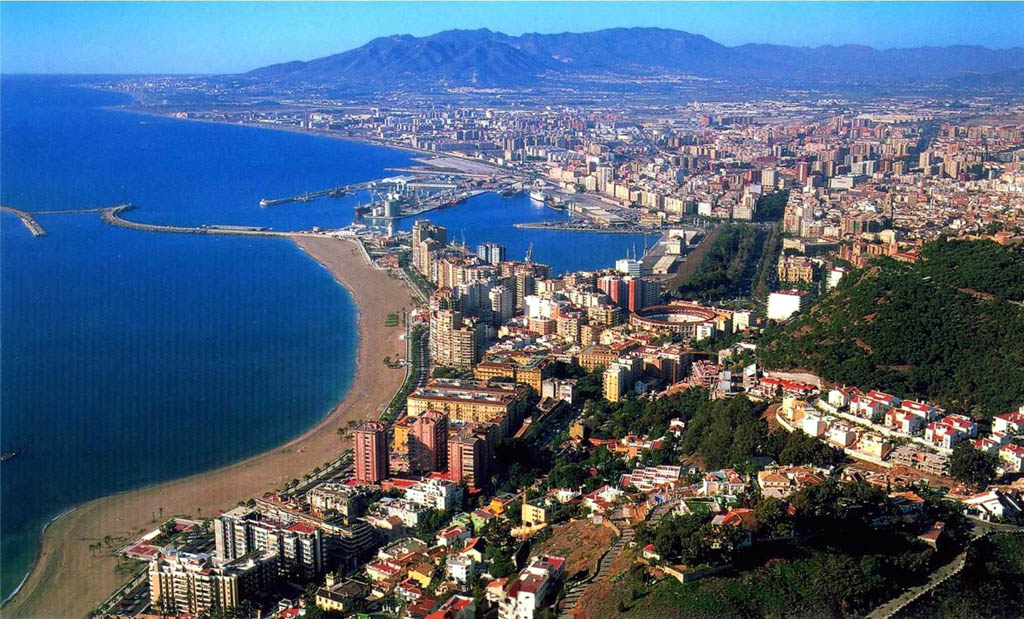Málaga's coastline forms part of The Costa del Sol, a special part of the Mediterranean -- so you are in for a treat during your Malaga vacation. The climate is temperate, with an average of 86°F during the summer months and 64°F during winter. This is due to the mountains that protect the coast from cold north winds.

Málaga was first a Phoenician colony and later came under the control of the Greeks, Carthaginians, Visigoths, Arabs, and Christians. Today it is a maritime city rich in culture, some of whose remains are on view at the Archeological Museum. The friendly people and wonderful climate also encourage a stroll through the old walls and the remains of the Muslim palaces of the Alcazaba fortress. Through its gardens next to the sea - they are adorned with palm and orange trees and jacaranda. Visitors can also visit the house where Picasso was born, there on the wide, lively Plaza de la Merced or take in the view of the city from the top of the Gibralfaro Castle.
Top Ten Things to do in Malaga
Finca La Concepcion – Considered one of the most important and the most beautiful botanical gardens in Europe, this 150-year-old botanical garden features giant ficus, araucarias (one 147-foot-tall specimen is the tallest tree in the province, palms, cycads, bamboo from China, and a wide variety of exotic flowers. Visitors can also stroll through the gardens and explore the many ornamental pools filled with waterlilys, frogs, turtles, and toads. One-hour guided tours are offered year round. Address: Carretera de las Pedrizas (SN 331). Take bus No. 61 from Alameda Principal in Central Malaga on weekends and holidays. Information: +34 952 252 148
Mueso Picasso Malaga – Museo Picasso Malaga is the city’s most renowned museum. It consists of 14 paintings, 9 sculptures, 44 drawings, a sketchbook from the Royan series containing 36 drawings, 58 engravings, and 7 ceramic pieces donated by Christine Ruiz-Picasso, widow of Picasso’s eldest child, Paul Ruiz-Picasso. In addition, the collection also includes 22 pieces donated by Picasso’s grandchild. Also onsite are Roman and Moorish remains, which were uncovered during restoration work on the palace that is now home to the museum. Museo Picasso Malaga is open Tuesday-Thursday 10:00 a.m.-8:00 p.m., Friday-Saturday 10:00 a.m.-9:00 p.m. and Sunday and holidays 10:00 a.m.-8:00 p.m. Address: C/San Agustin 8, Ph: +34 952 127 600, E-mail: info@museopicassomalaga.org, www2.museopicassomalaga.org.

La Alcazaba – La Alcazaba is a Malaga landmark that dates back to the 700s. The entrance, known as Christ’s Door or Puerta del Cristo, is where the first mass was celebrated after the Christian victory over the town. If you head just below the entrance to La Alcazaba you will find the ruins of an ancient amphitheatre dating back to the second century AD. Location: Calle Alcazabilla
Parador de Malaga Gibralfaro – This magnificent hotel features one of the best views Malaga has to offer. Located in the old quarter of the city on Mount Gibralfaro, this four star hotel features 38 elegant suites, a swimming pool on the top floor, an excellent restaurant, and a beautiful Picasso painting on the wall. All Parador de Malaga-Gibralfaro guests can use the facilities of the Parador del Golf, located on the outskirts of Malaga. Parador de Malaga Gibralfaro address: Castillo de Gibralfaro, s/n (29016) Malaga, Ph: +34 952 221 902, E-mail: gibralfaro@parador.es, www.parador.es. Average room rate 123EU ($200US).
The Cathedral – Malaga’s Cathedral also called “La Manquita” (one armed woman) due to only one completed tower, was built between 1528 and 1782. Just a few highlights include: 40 statues of the saints and a 16th century retable. The structure features beautiful stone work on the façade and Renaissance and baroque styles on the interior. Address: C. de Molina Larios, Ph: +34 952 215 917.
Museo Unicaja de Artes Populares – This arts and crafts museum features items used between the 17th and 20th centuries and other worthy pieces. On display are ceramic figures, clay figures, folk costumes, fishing equipment, furniture, horse-drawn carriages, and more. Hours are 10:00 a.m.-1:30 p.m. and 4:00 p.m.-7:00 p.m. Monday-Friday. Saturday 10:00 a.m.-1:30 p.m. Address: Pasillo de Santa Isabel, 10, Ph: +34 952 217 137, www.museoartespopulares.com.
Plaza de la Malagueta - Plaza de la Malagueta is the largest bullfighting ring in Malaga. The ring, designed by Joaquin Rucoba, opened in 1876 and it can hold up to 14,000 spectators. Marabella, which opened in 1964 holds up to 9,500 spectators and Antequera, opened in 1848, holds up to 8,200 spectators. There are more than a dozen bullrings in and around the city of Malaga. Plaza de la Malagueta is located at Calle de Cervantes, Ph: +34 852 221 727, www.la-malagueta.es. Hours: 9:00 a.m.-2:00 p.m. Monday-Saturday
Santiago Church – The foundation of this church dates back to July 25, 1490 making it the oldest church in Malaga. Pablo Picasso was baptized here in 1881. Major points of interest include the Mudejar Tower, sculptural works, and pictorial works such as Oil of the Virgin of the Child's Souls of Guevara, Christ's Baptism, an Apostle San Andrés, the Good Shepherd, the Immaculate Conception and the Virgin del Rosario. Santiago Church: Granada Street. Hours: 9:00 a.m.-1:30 p.m.
Gibralfaro Castle - Gibralfaro Castle/Fortress offers some of the most amazing panoramic views the city has to offer. This is the original place where Gibralfro lies and it is located next to La Alcazaba. Ducts from two of the castles towers connect La Alcazaba and Gibralfaro.
Town Hall – Town Hall is the most fascinating modernistic structure in Malaga. It was built between 1912 and 1919 and it features a neo-baroque style, gorgeous gardens, and excellent views of Alcazaba and Gibralfaro.
For more information about things to do and see in Malaga, visit the Malaga Tourism Board website at www.malagaturismo.com.


0 nhận xét:
Post a Comment